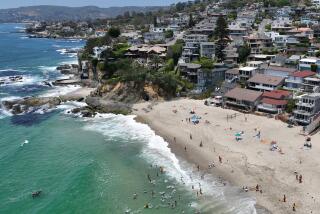Guard Hopefuls Brave Cold Sea : Ocean tryouts: Would-be lifeguards gasped on the beach after running near the Aliso Pier in South Laguna and swimming around it in the cold ocean as part of a series of tests.
LAGUNA BEACH — Tony Harris grabbed his stomach and panted. He had just finished first in a 1,200-yard run-and-swim test for prospective lifeguards at Aliso Beach, and he was paying a price.
“It’s the coldest I’ve ever been,” said a gasping Harris, 19, originally from Australia but now living in Costa Mesa. “When I first started in the water, I could not breathe.”
But he made it, along with 45 other men and women, all trying to be among the first batch of new lifeguards hired this year to patrol 15 county-run beaches.
The race was the first in a series of tests for applicants who hope to be chosen for lifeguard training by U.S. Ocean Safety Inc., a Laguna Beach company.
Earlier this year, U.S. Ocean Safety won a $632,000 contract over Lifeguard International Beach Services, which had provided its services to the county for the past 10 years. For the company’s founders--veteran Orange County lifeguards Mike Gaughan and Jack Lincke--that means hiring and training 60 lifeguards by April 7. All must be certified by the U.S. Lifesaving Assn.
The lifeguards, who will be paid $8.25 to $10.25 an hour, will be assigned to beach areas that include Sunset Beach, the county-owned beach immediately adjacent to the Santa Ana River mouth, Capistrano Beach and nine beaches south of Laguna Beach.
Sunday’s test also gave state officials a chance to interest applicants in their beaches. Gus Avila, a state beach lifeguard, was there passing out flyers, encouraging some who didn’t do so well Sunday to try out on April 1, when the state will conduct similar tests at Huntington State Beach.
“Some swimmers have bad days,” Avila said. “I’m here to tell them that they can try again.”
But after the drill, Lincke said that this pool of applicants had performed well. Only one man dropped out, deciding early on in the race that the waters were too frigid.
The rest braved the “run-swim-run-swim-run” course under cloudy skies and the threat of drizzle. Trained lifeguards guided the competitors as they ran down the beach, plunged into the water and swam around the Aliso Pier, got out of the water and ran farther down the beach. Then they jumped back into the water, swam around a buoy, then around the pier again, got out and sprinted to the finish line. Wet suits were not allowed.
“They have to be used to going in the water because if they’re a lifeguard, they don’t have the time to put on a wet suit,” said Logan Lockabey, a former Newport Beach lifeguard who was helping coordinate the testing. The race, he said, shows how applicants judge the surf, what shape they are in and how they pace themselves.
Applicants also must be 18 years or older and must have 20/40 uncorrected vision, Lockabey said. Later Sunday, the lifeguard hopefuls underwent a first-aid test and were quizzed about their knowledge of the beaches, surf and marine safety.
“We’re not picking people strictly on speed in the water,” Lockabey said. “It’s a lot of public relations work and work with other agencies.”
For many, getting selected will be worth it.
“It’s a fun job,” said Harris, who has been a “life-saver,” the Australian counterpart to a lifeguard. “You meet a lot of people.”
Many who tried out were former lifeguards who have an urge to get back to their old job. Some knew either Lincke or Gaughan, both of whom teach at Orange Coast College.
“Lifeguarding’s a small world,” said Gina Aubrey, 27, a former lifeguard in San Clemente. “It’s a pretty tight-knit bond up and down the coast.”
Aubrey, now an Orange County firefighter, finished eighth.
Also testing was Greg Boyer, 32, of Laguna Beach, who said the lifeguard job would help him pay expenses at Western State University College of Law in Fullerton. A member of the 1988 U.S. Olympic water polo team in Seoul, Boyer was also a lifeguard in Huntington Beach for several years. He finished ninth in the testing on Sunday.
“I won my trial when I was 17,” he said. “I guess people are getting faster and I’m getting slower.”
Like many others, Boyer said that he felt the pinch in the cold water.
“That water makes it seem warm out here,” he said, standing on the beach after the race. “It kind of separates the fair weather swimmers from the cold weather swimmers.”
For Robert Seely, 22, the water wasn’t the only thing he had to worry about. Applicants were told to stay as close as possible as they went around the pier. Seely scraped up against the pier, giving him a scratch on his leg. But he still finished 10th.
“I got stuck between a guy and a piling, and the piling got the best of me,” Seely said.
Sean Walsh, 18, a member of the Orange Coast College water polo team and native of Long Island, N.Y., said the prospect of working at the beach lured him into applying.
“It’s a job during the summer,” he said. “It looks like a lot of fun. . . . It’s the California thing to do.”
But another first-time applicant wondered if the job was worth the pain endured Sunday.
“One of my friends said it would be a fun thing to do,” Randy Jones, 18, a student at Orange Coast College, said after finishing the race. “After doing that, it better be fun.”
More to Read
Sign up for Essential California
The most important California stories and recommendations in your inbox every morning.
You may occasionally receive promotional content from the Los Angeles Times.










